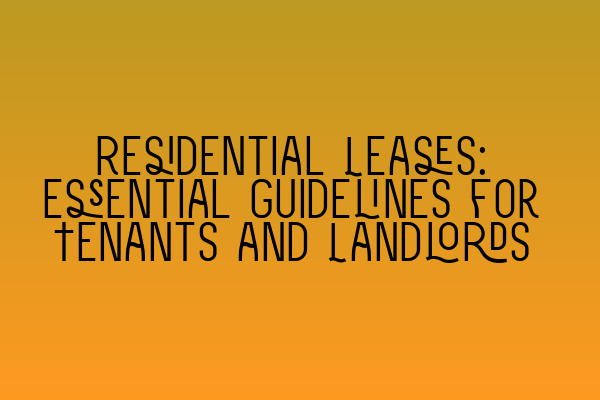Residential Leases: Essential Guidelines for Tenants and Landlords
Introduction:
A residential lease is a legally binding agreement between a landlord and a tenant. It outlines the terms and conditions for renting a property, ensuring a smooth and mutually beneficial relationship between both parties. Whether you are a tenant looking for a new home or a landlord seeking to lease your property, understanding the essential guidelines for residential leases is crucial.
In this article, we will provide you with a comprehensive guide on residential leases, covering everything from lease agreements to tenant rights and responsibilities. We aim to equip both tenants and landlords with the necessary knowledge to ensure a successful and stress-free tenancy.
Understanding the Residential Lease Agreement:
The lease agreement is the foundation of the tenancy. It is a legally binding contract that outlines the terms and conditions for renting a property. As a tenant, it is essential to carefully review the lease agreement before signing. Likewise, landlords should ensure that the lease agreement covers all necessary provisions and complies with the relevant laws and regulations.
When reviewing the lease agreement, pay close attention to the following key elements:
1. Duration of the lease: The lease should clearly state the duration of the tenancy, including the start and end dates. It is crucial to understand whether the lease is for a fixed term or periodic tenancy.
2. Rent and payment terms: The lease agreement should specify the amount of rent, how it should be paid (e.g., monthly, quarterly), and the due date. Additionally, it should outline any penalties for late payment or bounced checks.
3. Security deposit: A security deposit is a sum of money held by the landlord to cover any damages or unpaid rent. The lease agreement should clearly state the amount of the security deposit and how it will be handled at the end of the tenancy.
4. Maintenance responsibilities: The lease should outline who is responsible for maintenance and repairs, including any limitations or obligations for both the tenant and the landlord.
Tenant Rights and Responsibilities:
As a tenant, it is important to understand your rights and responsibilities to ensure a smooth and enjoyable tenancy. Here are a few key points to consider:
1. Right to a habitable property: Landlords have a legal obligation to provide a safe and habitable property. This includes ensuring that the property meets all relevant health and safety requirements.
2. Privacy rights: Tenants have the right to privacy within their rented property. Landlords should provide advance notice before entering the premises for non-emergency reasons.
3. Reporting repairs: Tenants should promptly report any necessary repairs to the landlord or property management company. It is important to keep documentation of all repair requests and communication.
4. Obeying the lease terms: Tenants must adhere to the terms and conditions outlined in the lease agreement. This includes paying rent on time, respecting noise regulations, and not causing damage to the property.
Landlord Obligations and Best Practices:
Landlords also have obligations to ensure a positive tenancy experience for their tenants. Here are some key obligations and best practices for landlords:
1. Property maintenance: Landlords are responsible for maintaining the property in a habitable condition. This includes addressing repairs promptly and ensuring the property meets all health and safety standards.
2. Providing notice: Landlords should provide advance notice before entering the property for non-emergency reasons. This allows tenants to prepare and respect their privacy.
3. Security deposit handling: It is vital for landlords to handle security deposits in accordance with the relevant laws and regulations. This includes providing tenants with an itemized list of deductions, if applicable, within a specified time frame.
4. Clear communication: Landlords should maintain open and transparent communication with tenants. This includes promptly addressing any concerns or issues raised by the tenant.
Conclusion:
Understanding the essential guidelines for residential leases is crucial for both tenants and landlords. By familiarizing themselves with the lease agreement, tenant rights, and landlord obligations, both parties can ensure a smooth and mutually beneficial tenancy.
If you would like further information on legal topics related to residential leases, please feel free to explore our related articles:
– Understanding Contractual Capacity: Rights and Limitations: https://contract-law-sqe.co.uk/understanding-contractual-capacity-rights-and-limitations/
– Interactive SQE Mock Tests for Contract Law: Test Your Knowledge: https://contract-law-sqe.co.uk/interactive-sqe-mock-tests-for-contract-law-test-your-knowledge/
– Join Our SQE Contract Law Webinars: Expert Insights and Guidance: https://contract-law-sqe.co.uk/join-our-sqe-contract-law-webinars-expert-insights-and-guidance/
– Contract Law Reforms: An Analysis of Recent Changes: https://contract-law-sqe.co.uk/contract-law-reforms-an-analysis-of-recent-changes/
– Parties in a Contract: Rights and Responsibilities: https://contract-law-sqe.co.uk/parties-in-a-contract-rights-and-responsibilities/
At SQE Property Law & Land Law, we are here to provide expert legal guidance and support. Contact us today for all your property law needs.
